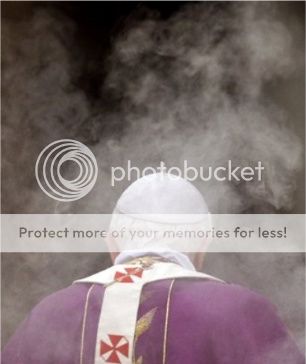
A week into the whirlwind sown by a NY Times article that traveled around the world before accuracy, fairness or balance could get their pants on, Cardinal William J. Levada, the pope’s successor as Prefect of the Congregation for the Doctrine of the Faith, has written a long and rather stunning reply to the Times, in which he writes very personally.
Rocco Palma, who reproduces the entire piece at his site, writes that in all the coverage and defense of the Pope you may have read, “you’ve seen nothing like this.
It is rather easy for a news vessel as large and powerful as the NY Times to smear and “take down” a public figure. All it takes is a few headlines and a thousand well (or poorly) crafted words; it takes many thousands of words to fairly defend the public figure and and bring clarity to the story, itself, once those headlines have been fired off.
Yesterday I linked to Jimmy Akin’s long, and detailed exposition, and found myself frustrated. People don’t want to read long-and-detailed. They want to read “representative excerpts” and I wanted to comply, but sometimes a thing simply cannot be excerpted. It must be read-in-full and really considered. Thinking must also apply.
Cardinal Levada’s piece is also exceedingly difficult to excerpt, but it is important, and needs to be read. Here is my poor-best try at an excerpt, but perhaps it is well to keep in mind the fact that Fr. Thomas Brundage, who adjudicated the case, has made it clear (as the Times does not) that the monstrous priest, Fr. Murphy, was “the defendant in a church criminal trial,” which came about specifically because Ratzinger’s office waived the statute of limitations that would have protected Murphy. As Brundage says, “No one seems to be aware of this.”
From Cardinal Levada’s piece:
In her lead paragraph, [Times reporter Laurie] Goodstein relies on what she describes as “newly unearthed files” to point out what the Vatican (i.e. then Cardinal Ratzinger and his Congregation for the Doctrine of the Faith) did not do – “defrock Fr. Murphy.” Breaking news, apparently. Only after eight paragraphs of purple prose does Goodstein reveal that Fr. Murphy . . . “not only was never tried or disciplined by the church’s own justice system, but also got a pass from the police and prosecutors who ignored reports from his victims, according to the documents and interviews with victims.”
But in paragraph 13, commenting on a statement of Fr. Lombardi (the Vatican spokesman) that Church law does not prohibit anyone from reporting cases of abuse to civil authorities, Goodstein writes, “He did not address why that had never happened in this case.” Did she forget, or did her editors not read, what she wrote in paragraph nine about Murphy getting “a pass from the police and prosecutors”? By her own account it seems clear that criminal authorities had been notified, most probably by the victims and their families.
Goodstein’s account bounces back and forth as if there were not some 20 plus years intervening between reports in the 1960 and 70’s to the Archdiocese of Milwaukee and local police, and Archbishop Weakland’s appeal for help to the Vatican in 1996. Why? Because the point of the article is not about failures on the part of church and civil authorities to act properly at the time. I, for one, looking back at this report agree that Fr. Murphy deserved to be dismissed from the clerical state for his egregious criminal behavior, which would normally have resulted from a canonical trial.
The point of Goodstein’s article, however, is to attribute the failure to accomplish this dismissal to Pope Benedict, instead of to diocesan decisions at the time. She uses the technique of repeating the many escalating charges and accusations from various sources (not least from her own newspaper), and tries to use these “newly unearthed files” as the basis for accusing the pope of leniency and inaction in this case and presumably in others.
And then, discussing the NY Times Editorial showcasing Goodstein’s story:
It is anachronistic for Goodstein and the Times to imply that the knowledge about sexual abuse that we have in 2010 should have somehow been intuited by those in authority in 1980.
…
But the Times editorial goes on to show the usual bias: “But then we read Laurie Goodstein’s disturbing report . . .about how the pope, while he was still a cardinal, was personally warned about a priest … But church leaders chose to protect the church instead of children. The report illuminated the kind of behavior the church was willing to excuse to avoid scandal.” Excuse me, editors. Even the Goodstein article, based on “newly unearthed files,” places the words about protecting the Church from scandal on the lips of Archbishop Weakland, not the pope. It is just this kind of anachronistic conflation that I think warrants my accusation that the Times, in rushing to a guilty verdict, lacks fairness in its coverage of Pope Benedict.
The piece is long. It is exhaustive. It takes great pains to lay out precisely how the church has responded to the revelations of the late 20th and early 21st centuries. It ends with a simple plea to the NY Times for “a more balanced view of a leader it can and should count on. ”
A plea that will fall on deaf ears, I am sure.
There has been an enormous and informative outpouring of words in response to the Times piece. A great deal of information is out there, either refuting, clarifying or bringing procedural understanding to bear in response to what the NY Times has written. Outside of the Catholic ghetto, almost none of it will be read. As we see repeatedly, in the press, once a headline has gone viral, and a narrative has been established, that narrative becomes “fact” for much of the world.
And at Holy Week, these headlines get especially loud and sensational.
The pope can take it. He ran away from his Nazi conscriptors in WWII and survived being a prisoner of war. He helped usher in the reforms of the Second Vatican Council and then endured the wrath of the “progressives” when their implementation of those reforms began to veer into strange territory. He has survived a great deal of hate and malice, and he’ll deal with this. And besides, the church has some of this coming. There is no way the Catholic church -as an institution and the individuals who comprise it- were not going to do a heavy penance for the sins of our priests, bishops, religious, laypersons and so forth. The purgation is needed.
But these annual Holy Week Festivals of Sensationalism, in which the press seems to highlight stories designed to shake faith, foment doubt and encourage hate, they do as much damage to the faithful -of all traditions- as these real sins.
I wonder, between the church injuring itself so gravely, and then the efforts of the press to bear down on Christianity in general, what is it the press actually wants? A world where the only choices left are Judaism (with a newly ascendant trend to global anti-semitism activated), Islamism and Secularism?
That would be a very interesting world to watch, wouldn’t it?
Meanwhile, even the NY Daily News -no fan of Benedict- is saying the Times blew it on this story
UPDATE I:
WOW. Still think the press isn’t actively trying to destroy the pope? My jaw is on the floor: NBC Apologies for egregiously untrue,shocking headline. More on that here.
Welcome Hot Air, Lucianne.com and National Review Online readers.
Related:
History, intelligently rendered, In Defense of Catholic Clergy
American Papist rounds up
Protestant Perspective on this
Weigel corrects the WaPo
Keeping the record straight
“Why can’t the media treat the pope fairly?
Papal Perspectives











